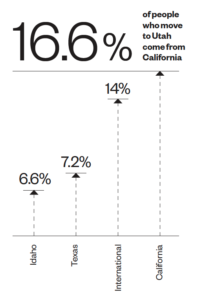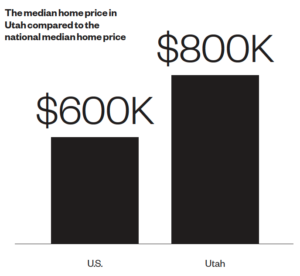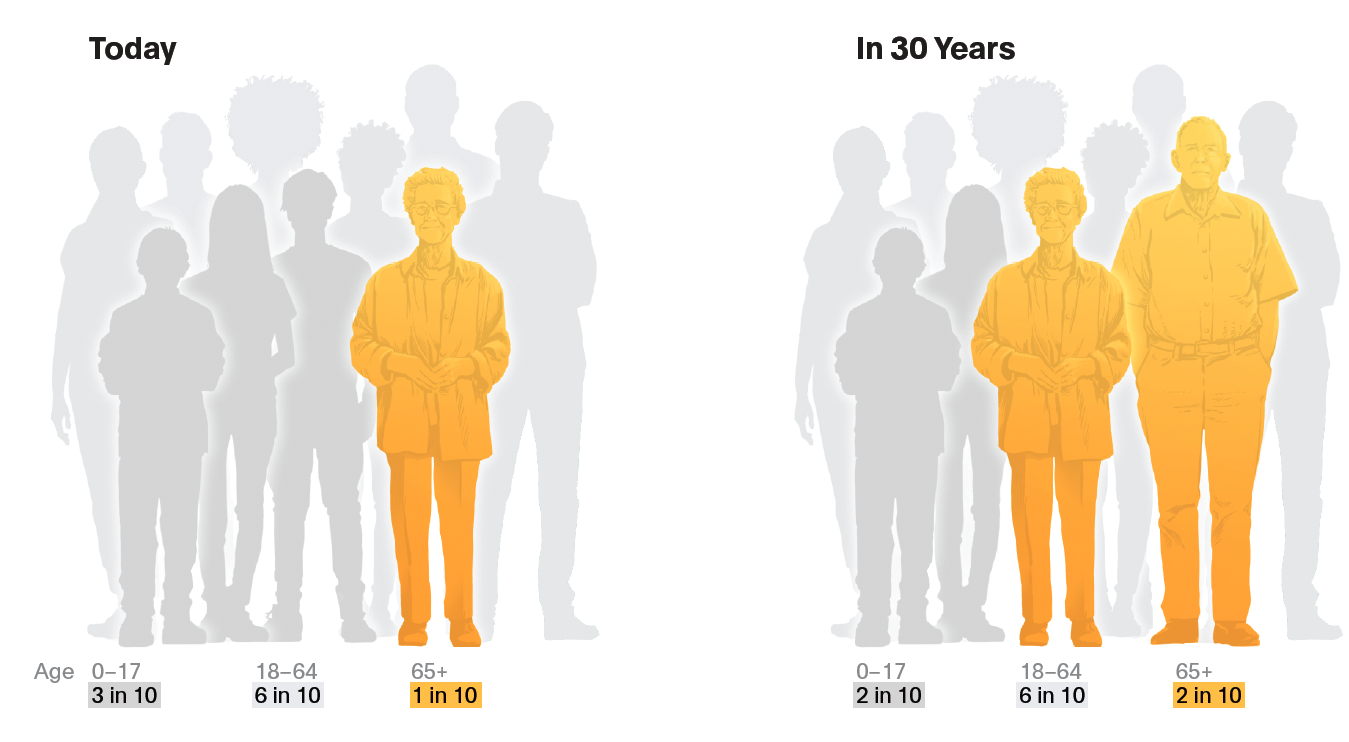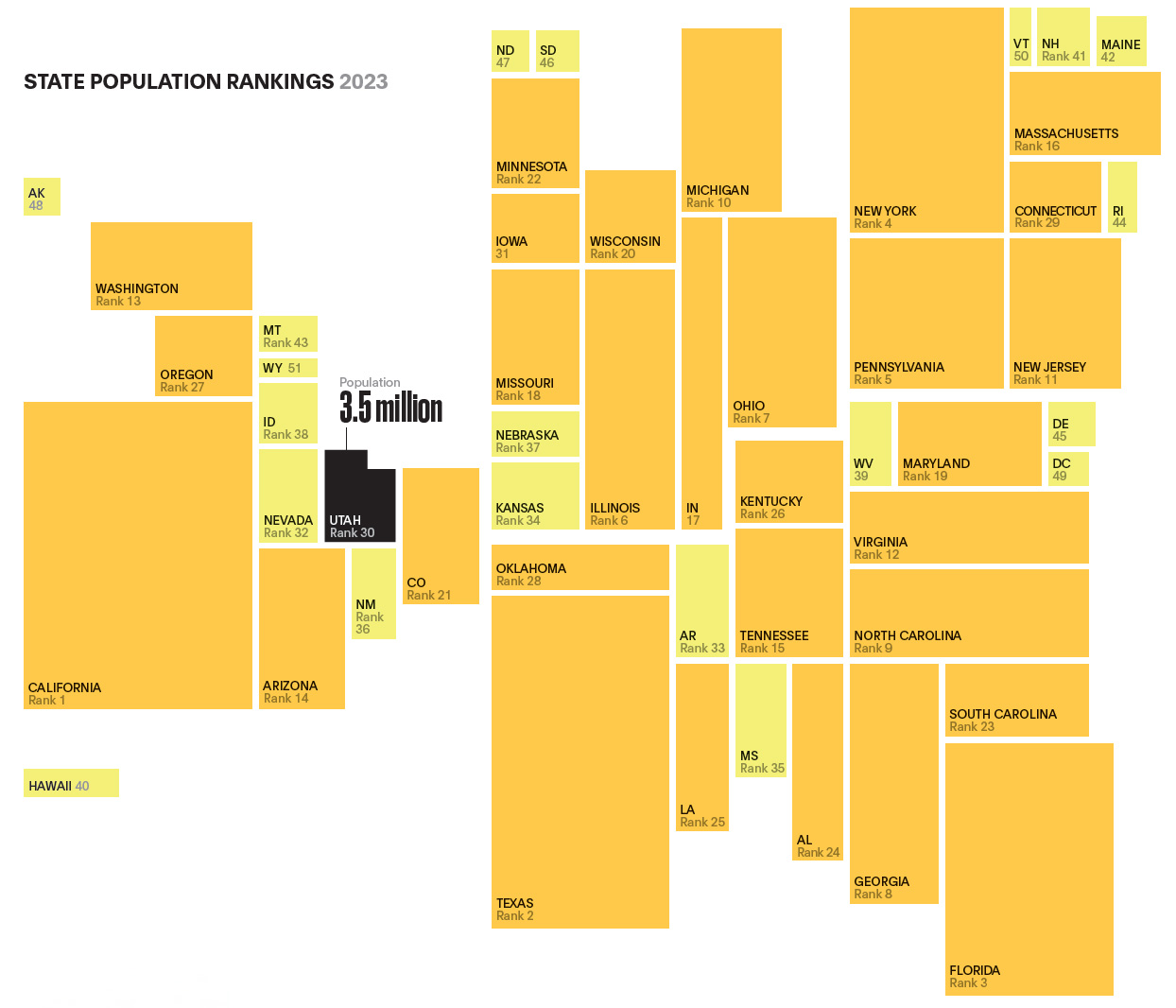Once upon a time, the Beehive State was buzzing with youth. Families were populating in affordable housing, driving on open freeways, and working in agriculture, mining, or the defense industry. It was a decent economy that had its ups and downs, but overall, it was fine. Then a steel mill closed. A copper mine eliminated jobs. Utah experienced seven years of net out-migration. Then came the year 2000, and things started to change further. The 2002 Olympic Winter Games were on the horizon. And in the headlights of a state speeding toward an unknown future, it appeared that Utah’s fate could go either way. The stage was set for the beginning of a new day.
Fast forward to the present, and the state is going strong. But Utah’s story is still one of change. With an aging population, shifting demographics, growth, a sizzling economy, increased diversity, and rising costs of housing, the state has pushed itself into another echelon through six key transitions. According to a report compiled by the U’s Kem C. Gardner Policy Institute, the “New Utah” has arrived, and with it, another turning point. The question now is, what comes next? And how does the University of Utah assist our community in these uncharted waters?
“Our work at the U has the potential to impact all Utahns,” says President Taylor Randall HBA’90. “We generate new discoveries to address the challenges of the day. We inspire success in our students who contribute to our hopeful future, and we serve our community. Whatever tomorrow brings, we are committed to being part of a brighter path forward.”
To consider the challenges that lie ahead, it’s important to understand where we are now. Here’s a deeper look at the key transitions Utah is experiencing.

1 | Welcome to a Mid-Sized State
If you doubt that Utah is in the midst of change, take note of the qualitative data around you: the rush hour traffic, the lines in the grocery store, the struggle to find parking. Utah has always been on a growth curve, but since the pandemic, its net in-migration has accelerated. No longer fitting within the small-state classification we’ve held since the 1900s, Utah is now a mid-sized state with a population of 3.5 million in 2023, surpassing 28 states plus the District of Columbia. We are projected to exceed 4 million people by 2030.
Population growth can be good—it draws new business to the state, creates opportunities, and drives political representation, according to the New Utah report. But there are some constraints. Lagging water availability, an increase in crime, and stress on existing transportation infrastructure are all potential consequences. These issues and others could impact the quality of life that Utahns enjoy.
“The New Utah requires a lot of innovation and ideas to either prevent or solve the problems that change and growth cause,” says Natalie Gochnour BS’84 MS’88, director of the Gardner Policy Institute and associate dean in the David Eccles School of Business. “I think the New Utah is a sign that we are an attractive, vibrant destination of choice, which is positive, but change requires leadership.”
2 | In-Migration Rules the Day
Over the last two years, in-migration —that is, people moving into the state—has contributed to nearly two-thirds of Utah’s population growth. In the past, Utah’s growth was mostly fueled by more births than deaths, but no more. Utah’s fertility rates have been below replacement level since 2018, falling steadily from 4.30 in 1960 to 1.92 in 2020.
The most significant reason for this migration is related to employment, according to the Gardner Policy Institute, but projections show an increase in migration based on retirement-related reasons in the future. In the next 30 years, it’s projected that 23 percent of those drawn to the state will come for retirement.
Of those moving to Utah from other states in the country, the highest percentage, 16.6 percent, are from California, followed by Texas at 7.2 percent and Idaho at 6.6 percent. Some 14 percent of migrants are international, but there is an interesting twist to this influx of arrivals. If you look at the birthplaces of those moving into Utah, 26.9 percent—or more than one in four—were actually born here, and they’re returning home.

3 | Houses Aren’t Cheap
These days, it is hard to find an affordable home in Utah.
With a median home price of $800K compared to the national median home price of $600K according to the U.S. Federal Housing Finance Agency, we’re outranked only by Hawaii, California, Massachusetts, Washington, Oregon, and Colorado. The rising costs of housing coincide with the rising number of people experiencing chronic homelessness in Utah, which increased 27 percent between 2022 and 2023.
 Some initiatives on campus, including Ivory Innovations, a nonprofit organization housed at the David Eccles School of Business, are dedicated to researching and catalyzing solutions in housing affordability. Meanwhile, the U is working to expand on-campus housing options, including adding a guarantee of available housing for fall 2024 first- year students who apply by the deadline for their preferred option.
Some initiatives on campus, including Ivory Innovations, a nonprofit organization housed at the David Eccles School of Business, are dedicated to researching and catalyzing solutions in housing affordability. Meanwhile, the U is working to expand on-campus housing options, including adding a guarantee of available housing for fall 2024 first- year students who apply by the deadline for their preferred option.
While each of the transitions that encapsulate how Utah is changing are significant, the challenge of housing affordability has far-reaching impacts, such as an impending difficulty of filling middle-class jobs, including nurses, police officers, firefighters, and teachers. Future decisions about these issues are crucial, as once again, a metaphorical crossroads appears in the distance.
“We’re at an inflection point,” says Gochnour. “If we handle it well, we can progress to a whole new level of prosperity or performance. If handled poorly, we may compromise our livability and standards of living. That’s a pretty serious statement—we have to handle this right.”
4 | We’re Getting Older
With fewer babies joining the ranks, the number of Utah’s residents who are 65 and older is projected to increase from roughly one in 10 today to one in five in the next 30 years. This shift could potentially change transportation, tax structure, health care, and the economy’s composition. The potential for added stress to our health care system is already on the radar of Michael Good, CEO for U of U Health and senior vice president for health sciences.
“As part of our commitment to making unsurpassed societal impact, we are responding to the interests and needs of our aging population,” notes Good. “The U joined the Age-Friendly University Global Network, and U of U Health is designated as an Age-Friendly Health System. Through campus and community collaboration, we’re enhancing the lives of older adults now and in the future.”

Other areas of research across the U are also focused on adapting to an aging population. U of U Health scientists are conducting research through a $7.5 million grant from the National Institute of Mental Health to see if web-based interventions—similar to a video game—can alleviate depression in older adults. Another project, Enhancing Active Caregiver Training, is an arts-based intervention intended to support caregivers of those with dementia. The Healthy Aging and Resilient Places (HARP) Lab, launched in 2021 with funding from the Center on Aging at the U, is an interdisciplinary research hub that catalyzes research focused on healthy aging and resilient places. Projects in the lab look at everything from fall risk mapping to developing new accessibility measures to support transportation for older adults.
“It’s such a pivotal time to have a Tier 1 research institution that is well-funded and engaging in these sorts of real-world problems on the ground and as they’re happening,” says Avery Holton, chair of the Department of Communication in the College of Humanities. “The university’s role in this is to become a change agent and produce innovative thinkers who have community in mind while considering the whole of what we are.”
5 | Next Level Economy
In 2000, Adobe co-founder John Warnock BS’61 MS’64 PhD’69 wanted to bring his company to Utah, but he worried there weren’t enough people to hire. He met with then-Gov. Mike Leavitt about his concerns, amid news that Geneva Steel had laid off its workers, Kennecott Utah Copper had shuttered its north concentrator, and construction was slowing as mortgage rates rose. The next year, Leavitt announced the Engineering and Computer Technology Initiative, which invested $2.5 million initially, and $1 million ongoing, in Utah’s higher education system to double the number of students graduating with majors in engineering, computer science, and math. It was a turning point for the state.
 “Our economic structure, like that of the nation’s, is undergoing a fundamental change,” Leavitt said at the time. “To succeed, our workforce must be prepared to enhance their skills and commit to lifelong learning. And government must respond by investing in infrastructure and education and preserving quality of life.”Today, Utah has moved from a strong economy to an elite economy, excelling in technology and science. The creation of key entities such as ARUP Laboratories, BioFire Diagnostics, Megahertz Corp., and Myriad Genetics—all of which have connections to the U—diversified and strengthened the state’s financial system. Since 2000, growth in engineering employment in Utah has outpaced the rest of the U.S. by more than fivefold, with Utah’s engineering and computer science workforce generating 12-15 percent of the state’s $200 billion economy in 2020.
“Our economic structure, like that of the nation’s, is undergoing a fundamental change,” Leavitt said at the time. “To succeed, our workforce must be prepared to enhance their skills and commit to lifelong learning. And government must respond by investing in infrastructure and education and preserving quality of life.”Today, Utah has moved from a strong economy to an elite economy, excelling in technology and science. The creation of key entities such as ARUP Laboratories, BioFire Diagnostics, Megahertz Corp., and Myriad Genetics—all of which have connections to the U—diversified and strengthened the state’s financial system. Since 2000, growth in engineering employment in Utah has outpaced the rest of the U.S. by more than fivefold, with Utah’s engineering and computer science workforce generating 12-15 percent of the state’s $200 billion economy in 2020.
The state’s investment paid off with higher numbers of graduates in computer science and engineering at Utah System of Higher Education institutions, blooming from 1,540 in 2000 to more than 3,700 in 2020. A majority of the graduates have come from the U.
“We see that our students have a critical impact on our community, as citizens and a potential workforce for the future,” says Senior Vice President for Academic Affairs Mitzi Montoya. “Our job, and our top priority, is to prepare them to be successful in whatever field they choose to pursue.”
6 | Richer Diversity
An upside of the increased numbers of people moving into the state is increased diversity. Nearly one in four Utahns is a racial or ethnic minority now, according to the New Utah report, which puts us ahead of states like Ohio, Minnesota, and Missouri. In the next 20 years, that ratio is projected to be one in three.
Utah’s diversity is becoming increasingly obvious in language classrooms at the U. Some 147 different languages are spoken in Utah homes, according to the 2022 Fall Enrollment report from the Utah State Board of Education, and students are looking to learn more through programs that stretch from kindergarten to college.
“Utah’s dual-language immersion and Bridge programs are like nothing else in the rest of the country,” says Christopher Lewis, chair of the U’s Department of World Languages and Cultures. “They are very forward-thinking programs, and it’s been visionary of the state legislature to be so supportive of them over the years. Otherwise, they wouldn’t work.”
At the U, some 1,400 students a year participate in the Bridge Program, a language pathway plan that offers early college concurrent enrollment credit to dual-language immersion students in grades 10-12.
Amy Choate-Nielsen is the PR and Communications manager for the Office of Academic Affairs.




Great job covering a lot of area in this story, in a concise, easy-to-digest format. I’ve lived in Utah my whole life and it’s been fascinating to see how it has changed over the past four decades. Always good to see your work, Amy.
I would like to apply there. I’m a senior here in WA, Hennry Foss HS and I’m interesting to look forward to attend in
“The University of UTAH”.
Thank you for sharing this. I am curious though — there was nothing under the “richer diversity” section about the recent legislation prohibiting the funding or maintenance of diversity, equity, and inclusion (DEI) offices. As a Utah alumna, it is disappointing to hear about this legislation, or really the lack of hearing about it, from the institution. It sounds like Utah is in a phase of change and I hope that all of the students will be supported through the transition.
I’m an early 80s U of U grad. My family quickly moved away because women could go nowhere with a degree. Lack of respect in the workforce.
This change is something to be proud of. Utah leadership took on a mountain higher than any climbs Utah mountain!
Congratulations!
What’s interesting about reading this is that since the beginning of this year, I have thoroughly researched the US to conclude that U is the right place for me to pursue a PhD in Computer Science. It’s incredible to see how much everyone in Utah is contributing to make the state better. As a person who loves change and growth, it was easy to identify with the state, the university, and the people. Irrespective of whether I make it in the admission process, I will continuously root for the university and the state in promoting change.
Utah is a fantastic school where the sky is the limit, but housing is going to eventually throttle out newcomers. $800k is not attainable for most people.